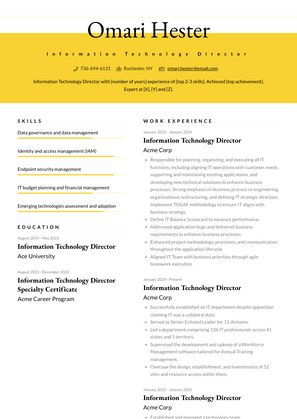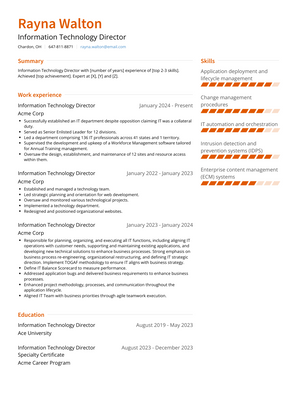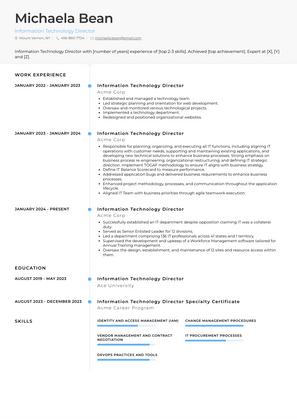Information Technology Director Resume Examples and Templates
This page provides you with Information Technology Director resume samples to use to create your own resume with our easy-to-use resume builder. Below you'll find our how-to section that will guide you through each section of a Information Technology Director resume.



What do Hiring Managers look for in an Information Technology Director Resume
- Leadership: Strong leadership skills to manage and guide the IT team effectively.
- Strategic Thinking: Ability to develop and implement IT strategies aligned with organizational goals.
- Technical Expertise: Proficiency in various IT domains, including networks, systems, and cybersecurity.
- Problem-Solving: Capability to address complex technical challenges and find innovative solutions.
- Communication: Excellent communication skills for liaising with stakeholders and conveying technical information effectively.
How to Write an Information Technology Director Resume?
To write a professional Information Technology Director resume, follow these steps:
- Select the right Information Technology Director resume template.
- Write a professional summary at the top explaining your Information Technology Director’s experience and achievements.
- Follow the STAR method while writing your Information Technology Director resume’s work experience. Show what you were responsible for and what you achieved as an Information Technology Director.
- List your top Information Technology Director skills in a separate skills section.
How to Write Your Information Technology Director Resume Header?
Write the perfect Information Technology Director resume header by:
- Adding your full name at the top of the header.
- Add a photo to your resume if you are applying for jobs outside of the US. For applying to jobs within the US, avoid adding photo to your resume header.
- Add your current Information Technology leadership position to the header to show relevance.
- Add your current city, your phone number and a professional email address.
- Finally, add a link to your portfolio to the Information Technology Director resume header. If there’s no portfolio link to add, consider adding a link to your LinkedIn profile instead.
Bad Information Technology Director Resume Example - Header Section
Caitlyn 167 Hamilton Drive Phillipsburg, NJ 08865 Marital Status: Married, email: cooldude2022@gmail.com
Good Information Technology Director Resume Example - Header Section
Caitlyn Bray, Phillipsburg, NJ, Phone number: +1-555-555-5555, Link: linkedin/in/johndoe
Make sure to add a professional looking email address while writing your resume header. Let’s assume your name is John Doe - here is a formula you can use to create email addresses:
- firstnamelastname@email.com - johndoe@email.com
- firstname.lastname@email.com - john.doe@email.com
- lastname.firstname@email.com - doe.john@email.com
- f.lastname@email.com - j.doe@email.com
- l.firstname@email.com - d.john@email.com
- firstnamelastname12@email.com - johndoe12@email.com
For a Information Technology Director email, we recommend you either go with a custom domain name (john@johndoe.com) or select a very reputed email provider (Gmail or Outlook).
How to Write a Professional Information Technology Director Resume Summary?
Use this template to write the best Information Technology Director resume summary: Information Technology Director with [number of years] experience of [top 2-3 skills]. Achieved [top achievement]. Expert at [X], [Y] and [Z].
How to Write a Information Technology Director Resume Experience Section?
Here’s how you can write a job winning Information Technology Director resume experience section:
- Write your Information Technology Director work experience in a reverse chronological order.
- Use bullets instead of paragraphs to explain your Information Technology Director work experience.
- While describing your work experience focus on highlighting what you did and the impact you made (you can use numbers to describe your success as a Information Technology Director).
- Use action verbs in your bullet points.
Information Technology Director Resume Example
Information Technology Director
- Successfully established an IT department despite opposition claiming IT was a collateral duty.
- Served as Senior Enlisted Leader for 12 divisions.
- Led a department comprising 136 IT professionals across 41 states and 1 territory.
- Supervised the development and upkeep of a Workforce Management software tailored for Annual Training management.
- Oversaw the design, establishment, and maintenance of 12 sites and resource access within them.
Information Technology Director Resume Example
Information Technology Director
- Responsible for planning, organizing, and executing all IT functions, including aligning IT operations with customer needs, supporting and maintaining existing applications, and developing new technical solutions to enhance business processes. Strong emphasis on business process re-engineering, organizational restructuring, and defining IT strategic direction. Implement TOGAF methodology to ensure IT aligns with business strategy.
- Define IT Balance Scorecard to measure performance.
- Addressed application bugs and delivered business requirements to enhance business processes.
- Enhanced project methodology, processes, and communication throughout the application lifecycle.
- Aligned IT Team with business priorities through agile teamwork execution.
Information Technology Director Resume Example
Information Technology Director
- Established and managed a technology team.
- Led strategic planning and orientation for web development.
- Oversaw and monitored various technological projects.
- Implemented a technology department.
- Redesigned and positioned organizational websites.
Top Information Technology Director Resume Skills for 2023
- IT strategic planning
- IT governance and policy development
- IT infrastructure design and management
- Network architecture design and implementation
- Cloud computing technologies (e.g., AWS, Azure)
- Virtualization technologies (e.g., VMware, Hyper-V)
- Server administration and optimization
- Storage area network (SAN) management
- Backup and disaster recovery planning
- Cybersecurity strategies and technologies
- Firewall management and configuration
- Intrusion detection and prevention systems (IDPS)
- Security information and event management (SIEM)
- Identity and access management (IAM)
- Encryption technologies
- Incident response and management
- IT risk assessment and mitigation
- Compliance with regulatory standards (e.g., HIPAA, GDPR)
- IT project management methodologies (e.g., Agile, Waterfall)
- Software development lifecycle (SDLC) management
- Application deployment and lifecycle management
- DevOps practices and tools
- Continuous integration and continuous deployment (CI/CD)
- Database management systems (e.g., SQL Server, Oracle)
- Data governance and data management
- Business intelligence and analytics tools
- Data warehousing and data lakes
- IT service management (ITSM) frameworks (e.g., ITIL)
- Help desk management and support
- IT asset management (ITAM)
- Vendor management and contract negotiation
- IT budget planning and financial management
- Cost optimization strategies
- IT procurement processes
- Change management procedures
- ITIL processes (incident management, problem management, etc.)
- Enterprise resource planning (ERP) systems
- Customer relationship management (CRM) systems
- Enterprise content management (ECM) systems
- Collaboration and communication platforms (e.g., Microsoft Teams, Slack)
- Mobile device management (MDM) solutions
- Endpoint security management
- IT automation and orchestration
- Network monitoring and performance optimization
- Unified communications technologies
- Internet of Things (IoT) platforms and solutions
- Emerging technologies assessment and adoption
- IT talent management and team leadership
- Stakeholder management and communication
How Long Should my Information Technology Director Resume be?
Your Information Technology Director resume length should be less than one or two pages maximum. Unless you have more than 25 years of experience, any resume that’s more than two pages would appear to be too long and risk getting rejected.
On an average, for Information Technology Director, we see most resumes have a length of 2. And, that’s why we advise you to keep the resume length appropriate to not get rejected.
-
What do Hiring Managers look for in an Information Technology Director Resume
-
How to Write Your Information Technology Director Resume Header?
-
How to Write a Professional Information Technology Director Resume Summary?
-
How to Write a Information Technology Director Resume Experience Section?
-
How Long Should my Information Technology Director Resume be?
Copyright ©2025 Workstory Inc.
